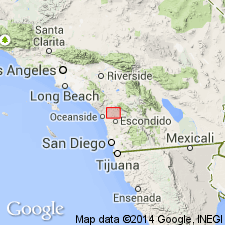
- Usage in publication:
-
- Bonsall tonalite
- Modifications:
-
- Original reference
- Dominant lithology:
-
- Tonalite
- Quartz diorite
- AAPG geologic province:
-
- Peninsular Ranges province
Summary:
Pg. 611-613. Bonsall tonalite. Medium-grained plutonic rock presenting in outcrop a color of varying shades of gray which distinguishes it in the field from other intrusives. Characterized by abundant dark inclusions. Shows marginal assimilation at contact with San Marcos Mountain gabbro (new) which it intrudes. Report includes chemical analyses. Age is Jurassic.
Type locality not stated. Named from village of Bonsall located slightly west of central San Luis Rey 30- by 60-min quadrangle, San Diego Co., southern CA. Underlies approx. 100 sq mi in San Luis Rey quadrangle; also present in Elsinore and Ramona quadrangles.
Source: US geologic names lexicon (USGS Bull. 1200, p. 428-429); supplemental information from GNU records (USGS DDS-6; Menlo GNULEX).
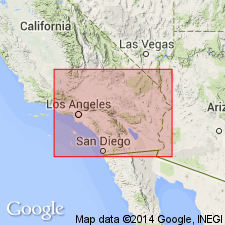
- Usage in publication:
-
- Bonsall tonalite
- Modifications:
-
- Areal extent
- AAPG geologic province:
-
- Capistrano basin
Summary:
Table facing p. 630. Bonsall tonalite. In late Mesozoic plutonic sequence in central and northwestern San Diego County, California, Bonsall tonalite is listed as older than Lakeview tonalite and younger than Green Valley tonalite.
Source: US geologic names lexicon (USGS Bull. 1200, p. 428-429).

- Usage in publication:
-
- Bonsall tonalite*
- Modifications:
-
- Adopted
- Age modified
- Areal extent
- AAPG geologic province:
-
- Peninsular Ranges province
Summary:
Pg. 58-62, pl. 1. Bonsall tonalite of Hurlbut (1935) is adopted. In this report, name Bonsall tonalite (has slight priority) replaces name Perris quartz diorite as used by Dudley (1935) and Val Verde tonalite used by Osborn (1939) in Elsinore quadrangle. Underlies area of about 250 sq mi extending into Ramona and Elsinore quadrangles. Intruded by Woodson Mountain granodiorite (new) and Indian Mountain granodiorite [leucogranodiorite] (new). Considered younger than Lakeview Mountain tonalite (new). Age is Late Cretaceous. [Age on legend of geologic map is Cretaceous.]
Source: US geologic names lexicon (USGS Bull. 1200, p. 428-429); supplemental information from GNU records (USGS DDS-6; Menlo GNULEX).
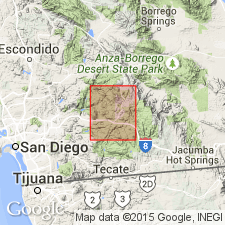
- Usage in publication:
-
- Bonsall tonalite*
- Modifications:
-
- Areal extent
- Age modified
- AAPG geologic province:
-
- Peninsular Ranges province
Summary:
Bonsall tonalite. Underlies about 65 sq mi in Cuyamaca Peak 15-min quadrangle, San Diego County, California. Occurs in strip of irregular outline that trends northwest across quadrangle. Age is considered Late Cretaceous.
Bonsall is distributed through nearly all of southern California batholith.
Source: Modified from GNU records (USGS DDS-6; Menlo GNULEX).
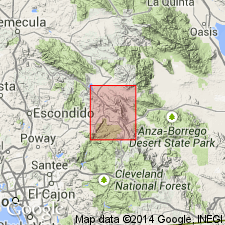
- Usage in publication:
-
- Bonsall tonalite*
- Modifications:
-
- Areal extent
- AAPG geologic province:
-
- Peninsular Ranges province
Summary:
Pg. 14, 16 (fig. 2). Bonsall tonalite. Described and mapped in Santa Ysabel 15-min quadrangle, San Diego County, California. Younger than Green Valley tonalite. Age is Cretaceous.
Source: US geologic names lexicon (USGS Bull. 1200, p. 428-429).

- Usage in publication:
-
- Bonsall Tonalite*
- Modifications:
-
- Age modified
- AAPG geologic province:
-
- Peninsular Ranges province
Summary:
Bonsall Tonalite of Late Cretaceous age recognized in San Luis Rey River valley area.
Source: GNU records (USGS DDS-6; Menlo GNULEX).
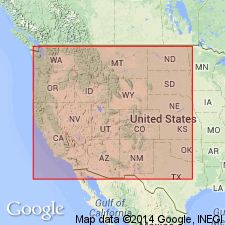
- Usage in publication:
-
- Bonsall Tonalite*
- Modifications:
-
- Geochronologic dating
- AAPG geologic province:
-
- Peninsular Ranges province
Summary:
Pg. 10, geologic time scale (inside front cover). Bonsall Tonalite. Sample from a coarse-grained xenolith, in Val Verde Tunnel dump, Lat. 33 deg. 50 min. 15 sec. N., Long. 117 deg. 19 min. 00 sec. W., Steele Peak quadrangle, Riverside County, California. Pb-alpha age on zircon 110 +/-10 Ma [Cretaceous]; age not evaluated. Age calculated using decay constants of Steiger and Jager, 1977 (Earth Planet. Sci. Letters, v. 36, p. 359-362).
Source: Publication.
For more information, please contact Nancy Stamm, Geologic Names Committee Secretary.
Asterisk (*) indicates published by U.S. Geological Survey authors.
"No current usage" (†) implies that a name has been abandoned or has fallen into disuse. Former usage and, if known, replacement name given in parentheses ( ).
Slash (/) indicates name conflicts with nomenclatural guidelines (CSN, 1933; ACSN, 1961, 1970; NACSN, 1983, 2005, 2021). May be explained within brackets ([ ]).

